ACUFO-1945-04-04-TOKYOBAY-2
The Air Intelligence Report secret bulletin, XXIst Bomber Command, U.S. Army Air Forces of April 26, 1945, contained an article about the “balls of fire” phenomena encountered by B-29 crews of this Command in their raids over Japan in 1945.
After a presentation of the “Baka” aka “Viper” piloted rocket suicide bomb, a chapter titled “Are these fireballs?” expanded on whether this craft was the “balls of fire”.
12 examples of reports of “balls of fire” were cited; generally without date or location or information on the involved unit. Report 8 was:
“Just after leaving secondary target on course of 180 degrees and at 7,000 feet, observed what appeared to be ball of fire falling at about four o'clock. B-29 immediately took evasive action gaining and losing 500 feet and also changing course as much as 35 degrees and varying airspeed from 205 to 250. As a result B-29 lost ball of fire on three occasions when it passed through clouds; but ball of fire was on its tail. Fire appeared to be steady phosphorescent glow and ball of fire stayed for about five minutes.”
The article noted that this was one of the most puzzling of these reports, with the ball of fire appearing to have characteristics which would tend to demonstrate human control, a capacity of the “Viper”; but “the reason for their absence from daytime missions is not easily explained. In like manner, it is difficult to explain this phenomena in terms of normal jet or rocket-propelled fighters such as have been used by the Germans in the European Theater of Operations. Perhaps the simplest explanation is that these balls of fire are generated in an unknown fashion by a conventional Japanese night fighter.”
The report concluded:
“The problem is as yet unsolved.”
In the 2000's, ufologists found the same sighting report in its first military source, the Report of operation of 3-4 April 1945, of the XXIst Bomber Command; which allows indicating that this sighting occurred over the Tokyo Bay, on April 4, 1945, at 03:14 a.m. local time. The original report read:
“At 1814 (zulu), the pilot and crew of a B-29 flying on 120° heading and at 7,000 ft high, observed at 4 o'clock a ball of fire following the plane. The pilot took evasive actions three times through clouds but could not loose the phenomenon which had a phosphorescent glow. It stayed 5 minutes with the bomber across Tokyo Bay after that it disappeared.”
| Date: | April 4, 1945 |
|---|---|
| Time: | 03:14 a.m. |
| Duration: | ? |
| First known report date: | April 4, 1945 |
| Reporting delay: | Hours. |
| Country: | Japan |
|---|---|
| State/Department: | Kanto |
| City or place: | The Tokyo bay |
| Number of alleged witnesses: | 1 to 11 |
|---|---|
| Number of known witnesses: | ? |
| Number of named witnesses: | 0 |
| Reporting channel: | Military operations report, Air Intelligence article. |
|---|---|
| Visibility conditions: | Night. |
| UFO observed: | Yes. |
| UFO arrival observed: | ? |
| UFO departure observed: | Yes. |
| UFO action: | Follows despite evasive maneuvers in clouds. |
| Witnesses action: | Evasive actions. |
| Photographs: | No. |
| Sketch(s) by witness(es): | No. |
| Sketch(es) approved by witness(es): | No. |
| Witness(es) feelings: | ? |
| Witnesses interpretation: | ? |
| Sensors: |
[X] Visual: 1 to 11.
[ ] Airborne radar: [ ] Directional ground radar: [ ] Height finder ground radar: [ ] Photo: [ ] Film/video: [ ] EM Effects: [ ] Failures: [ ] Damages: |
|---|---|
| Hynek: | NL |
| Armed / unarmed: | Armed, 12 Browning M2 12,7 mm machine guns. |
| Reliability 1-3: | 3 |
| Strangeness 1-3: | 2 |
| ACUFO: | Possible extraterrestrial craft, or Jupiter. |
[Ref. aaf2:] U.S. ARMY AIR FORCES:
After a presentation of the “Baka” aka “Viper” piloted rocket suicide bomb (see my Discussion section), a chapter title “Are these fireballs?” expanded on whether this craft was the “balls of fire” reported by B-29 pilots in the Pacific in 1944 - 1945.
12 examples of reports of “balls of fire” are cited; unfortunately, generally without date or location or information on the involved unit.
The introduction read:
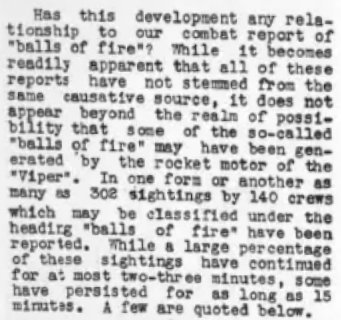
|
Has this development [the “Baka” aka “Viper”] any relationship to our combat reports of “balls of fire”? While it becomes readily apparent that all of these reports have not stemmed from the same causative source, it does not appear beyond the realm of possibility that some of the so-called “balls of fire” may have been generated by the rocket engine of the “Viper”. In one form or another as many as 302 sightings by 140 crews which may be classified under the heading of “balls of fire” have been reported. While a large percentage of these sightings have continued for at most two-three minutes, some have persisted for as long as 15 minutes. A few are quoted below.
Quoted below were indeed 12 reports summaries, including:
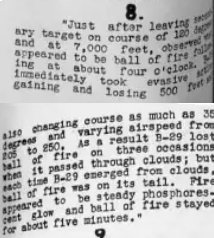
|
“Just after leaving secondary target on course of 180 degrees and at 7,000 feet, observed what appeared to be ball of fire falling at about four o'clock. B-29 immediately took evasive action gaining and losing 500 feet and also changing course as much as 35 degrees and varying airspeed from 205 to 250. As a result B-29 lost ball of fire on three occasions when it passed through clouds; but ball of fire was on its tail. Fire appeared to be steady phosphorescent glow and ball of fire stayed for about five minutes.”
The reports were followed by these comments:
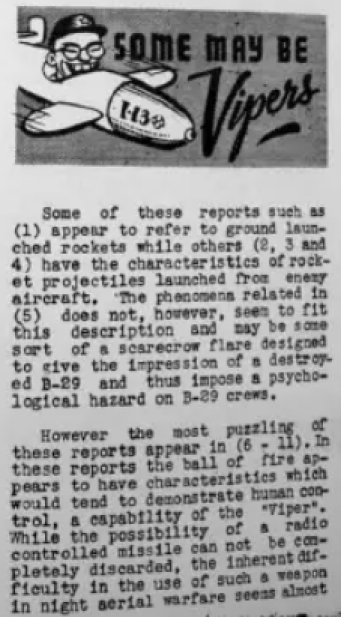
|
Some of these reports such as (1) appear to refer to ground launched rockets while others (2, 3 and 4) have the characteristics of rocket projectiles launched from enemy aircraft. The phenomena related in (5) does not, however, seem to fit this description and may be some sort of a scarecrow flare designed to give the impression of a destroyed B-29 and thus impose a psychological hazard on B-29 crews.
However the most puzzling of these reports appear in (6 - 11). In these reports the ball of fire appears to have characteristics which would tend to demonstrate human control, a capacity of the “Viper”. While the possibility of a radio controlled missile ca not be completely discarded, the inherent difficulty in the use of such a weapon in night aerial warfare seems almost
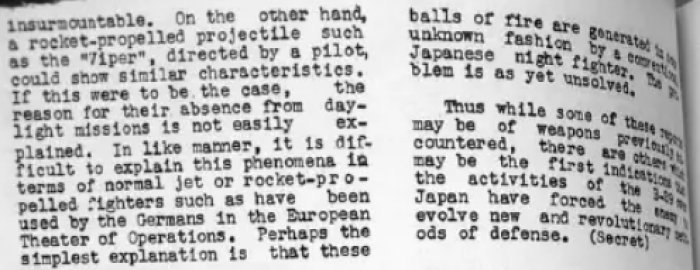
|
insurmountable. On the other hand, a rocket-propelled projectile such as the “Viper”, directed by a pilot, could show similar characteristics.
If this were to be the case, the reason for their absence from daytime missions is not easily explained. In like manner, it is difficult to explain this phenomena in terms of normal jet or rocket-propelled fighters such as have been used by the Germans in the European Theater of Operations. Perhaps the simplest explanation is that these balls of fire are generated in an unknown fashion by a conventional Japanese night fighter. The problem is as yet unsolved.
Thus while some of these reports may be of weapons previously encountered, there are others which may be the first indications that the activities of the B-29 have forced the enemy to evolve new and revolutionary methods of defense. (Secret)
[Ref. kap1:] KENNETH ARNOLD AND RAY PALMER:
One of the most baffling mysteries of the Second World War were strange aerial apparitions in the shape of blazing balls which were encountered over Truk Lagoon, [...other places...]
[...]
In 1945 the foo fighters made their appearance in the seas of the Far East - the other side of the globe from the German Rhine - over Japan, and over Truk Lagoon. Crews of U.S. B-29 bombers reported to intelligence that balls of fire of mysterious types came up from below their cockpits over Japan, hovered over the tails of their bombers, winked their lights from red to orange, then back from red to white. It was the same thing that had happened a few months before on the other side of the globe over the Rhine! Here too the weird balls were inoffensive - just nosey and exploratory, albeit, unnerving.
One night a B-29 pilot rose into a cloud in order to shake one of these balls of fire. When this plane emerged from the cloud-bank the ball was still following him! He said it looked to be about three and one half feet wide and glowed with a strange red phosphorescence. It was spherical, with not one sign of any mechanical appendage such as wings, fins or fuselage. It followed the bomber for five or six miles and he lost sight of it as the dawn light rose over Mount Fujiyama, some 60 miles southerly of Tokyo. Here it seemed to vanish into thin air!
The B-29's found that even at top speed they could not outdistance these balls of fire.
[Ref. prt4:] JAN ALDRICH - "PROJECT 1947":
N - 1945.04.03, 1814Z - Tokyo Bay area.
B-29 heading 120 degs., 7000 feet ball of fire observed at 4 o'clock position following aircraft. Evasive action through clouds 3 time could not loose the object which had a phosphorescent glow. Stayed with B-29 for 5 minutes across Tokyo Bay after that it disappeared. (Report of Operation 3-4 April 1945, HQ 21st Bomber Command)
[Ref. prt5:] JAN ALDRICH - "PROJECT 1947":
N - 1945.04.03, - 1813Z, Tokyo Bay area flying across the peninsula at land's end
B-29, heading 115 degs., 8000 feet, light observed following and closing on B-29 while gaining altitude. Ball of fire followed aircraft despite evasive maneuvers. Picked up on radar. Followed aircraft to about 25 to 30 miles beyond the coast over the ocean. (Report of Operation 3-4 April 1945, HQ 21st Bomber Command)
[Ref. gvo1:] GODELIEVE VAN OVERMEIRE:
1945, April 3
JAPAN, Tokyo Bay
At 6:17 p.m. ZT the pilot of a B 29 saw a ball of fire following the aircraft, all the pilot's evasive maneuvers remained in vain. (PROJECT ACUFOE, Catalog 1999, Dominique Weinstein)
[Ref. dwn1:] DOMINIQUE WEINSTEIN:
At 1814 (zulu), the pilot and crew of a B-29 flying on 120°heading and at 7,000 ft high, observed at 4 o'clock a ball of fire following the plane. The pilot took evasive actions three times through clouds but could not loose the phenomenon which had a phosphorescent glow. It stayed 5 minutes with the bomber across Tokyo Bay after that it disappeared.
Sources: Project 1947, Jan Aldrich / Report of operation 3-4 April 1945, HQ 21st Bomber Command.
[Ref. dwn3:] DOMINIQUE WEINSTEIN:
At 1813 (zulu), the pilot of a B-29 flying across the peninsula at land's end on 115° heading and at 8,000 ft high, observed one light following and closing the aircraft while gaining altitude. The ball of fire followed the aircraft despite evasive maneuvers. It followed the aircraft to about 25-30 miles beyond the coast over the Ocean. The phenomenon was picked up on radar.
Sources: Project 1947, Jan Aldrich / Report of operation 3-4 April 1945, HQ 21st Bomber Command.
[Ref. dwn2:] DOMINIQUE WEINSTEIN:
At 1814 (zulu), the pilot and crew of a B-29 flying on 120° heading and at 7,000 ft high, observed at 4 o'clock a ball of fire following the plane. The pilot took evasive actions three times through clouds but could not loose the phenomenon which had a phosphorescent glow. It stayed 5 minutes with the bomber across Tokyo Bay after that it disappeared.
Sources: Project 1947, Jan Aldrich / Report of operation 3-4 April 1945, HQ 21st Bomber Command.
[Ref. dwn4:] DOMINIQUE WEINSTEIN:
At 1813 (zulu), the pilot of a B-29 flying across the peninsula at land's end on l15° heading and at 8,000 ft high, observed one light following and closing the aircraft while gaining altitude. The ball of fire followed the aircraft despite evasive maneuvers. It followed the aircraft to about 25-30 miles beyond the coast over the Ocean. The phenomenon was picked up on radar.
Sources: Project 1947, Jan Aldrich / Report of operation 3-4 April 1945, HQ 21st Bomber Command.
[Ref. tai1:] "THINK ABOUT IT" WEBSITE:
Date: Apr. 3/4, 1945
Location: Honshu, Japan
Time:
Summary: Multiple balls of fire sightings: size of basketball; streamer of light behind the ball of fire; ball of fire emitting a steady phosphorescent glow; wing in connection with ball of fire & amber colored searchlight; stream of fire emanating from object, twelve inches in diameter, followed through evasive action.
Source:
[Ref. kre2:] KEVIN RANDLE:
On April 3, 1945 according to the XXI Bomber Command's Tactical Report, flight crews mentioned “Balls of Fire” as the only enemy opposition. According to Chester, the best of these was from a crew of the 73rd Bombardment Wing. Chester wrote:
“According to Lt. Althoff, they had just completed bombing the secondary target and were approaching land's end. Their altitude was 9,000 feet at the time when he first saw the “ball of fire” coming in on his B-29 at about the five o clock [position]. It was about 300 yards behind his B-29 and the “ball of fire” was about the size of a basketball. Immediately, evasive action was taken, but the ball of fire cut to the inside of the plane and continued to follow. Lt. Althoff said that it appeared that the ball of fire could not keep up with the B-29's evasive maneuvers, weaving turns, but when the bomber was flying straight, the ball of fire caught up to them. One of the other crewmen said he saw a streamer of light behind the ball of fire, which was faint and not steady. The light faded as it turned with the B-29, but increased in intensity on the straightaway.”
“Playing cat and mouse, the B-29 and its pursuer were over the Pacific Ocean. Diving to 6,000 feet, the B-29 was able to obtain additional air speed, and the ball of fire fell behind, eventually turned around, and gave up its pursuit, heading back to the coast. Watching the object retreat, Lt. Althoff noticed as streamer of light, but then the light faded abruptly. The blister gunner thought he had seen a wing in connection with ball of fire; and it had a navigation light burning on left wing tip. But now the chase was over. It had followed them for approximately six minutes.”
“Lt. Schmidt was in another B-29. His plane had departed the target area, which they bombed from 6,100 feet. Gaining another 900 feet, he noticed a ball of fire, emitting a steady phosphorescent glow, following him. Immediately the B-29 took evasive action, gaining and losing 500 ft. and also changing course as much as 35 degrees and varying airspeed from 205 to 250. Flying into the clouds, they thought the maneuver had worked, but as they emerged, the ball of fire was right on the B-29's tail. Twice more the pilot steered his bomber into the clouds and twice more when he came out, the ball of fire was right there behind his plane. Then, over Tokyo Bay, the ball of fire disappeared not too far behind the fleeing B-29.”
These sorts of reports would continue throughout the Pacific Theater and throughout the rest of the war. As had been noticed in Europe, the aircraft were not damaged by the encounters. The aircrews reported them, as they would anything else that they observed that might affect follow on missions. As happened in Europe, intelligence officers and the command staffs were worried about the deployment of a new type of anti-aircraft weapon. They investigated carefully, but they could find nothing to explain these balls of fire or what they might be. Please note that they found nothing to explain what the flight crews had seen.
[Ref. get1:] GEORGE M. EBERHART:
April 3 4 - US B-29 bombers over Honshu, Japan, encounter numerous balls of light tagging along with them. (Strange Company 157 159)
The Boeing B-29 “Superfortress” was the heaviest bomber of the U.S. Army Air Forces, used in operations from May 8, 1944 and on. Its maximum speed was 574 km/h.
Its defensive armament was 12 Browning M2 12.7 mm machine guns.
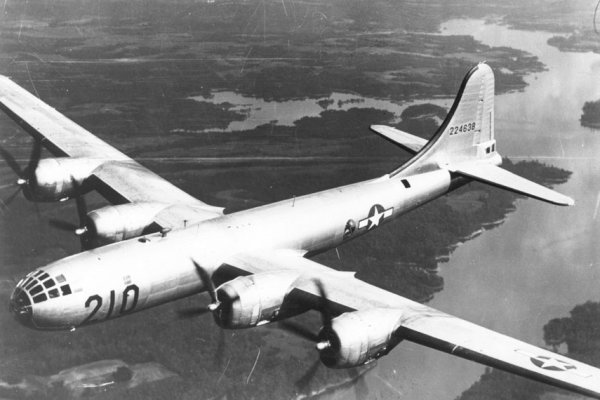
|

|
Robert E. “Bob” Althoff (photos below) passed away on August 26, 2005. He was a World War II veteran of the United States Air Force as a First Lieutenant and B-29 bomber pilot with the 500th Bomb Group in Saipan. He flew 35 missions over Japan during WWII.
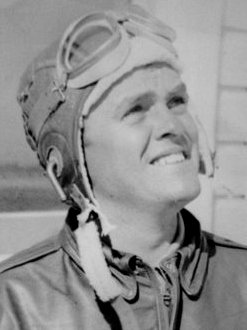
|
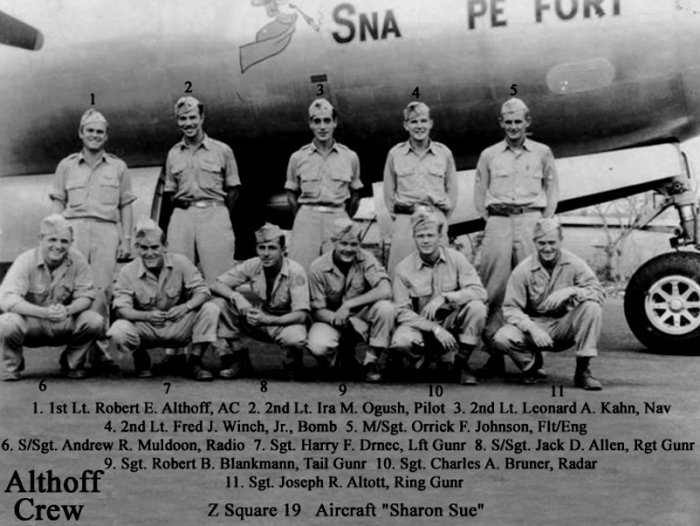
|
“Baka” (photo below), or “Viper”, was the allied code name for the Yokosuka MXY-7 “Ohka”, a rocket-powered human-piloted kamikaze attack aircraft used by the Japanese air forces against Allied ships towards the end of the Pacific War during World War II. It was extremely fast, but with a very short range, so that it had to be carried into action as a parasite aircraft by a much larger bomber.
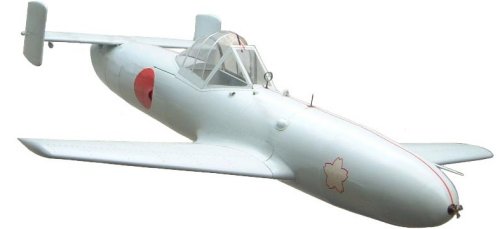
|
The 73rd Bomb Wing, attached to the XXIst Bomber Command of the 20th Air Force, was one of five bomb wings of the US Army Air Forces assigned to attack Japan during WWII, operating from Isely Field on Saipan in the Marianas islands.
The 73rd Bomb Wing was made of 4 Bomb Groups, all flying B-29's: 497th, 498th, 499th and 500th.
Given the sighting date, it seems to have occurred during night Mission No. 38, against the Tachikawa Engine Plant, or Mission No. 39, against the Musashino Aircraft Engine plant near Tokyo.
We find in this observation several typical characteristics of what has been called the “Foo-Fighters”: the following maneuvers despite the evasive maneuvers of the plane, and the absence of attack.
In the present case, we can of course exclude a rocket, a missile, an air-air bomb, a balloon, a meteor, a ground searchlight, a flare, etc. The “ordinary” explanation that would be “least worse” is that of an enemy plane. But the behavior does not correspond to it, the “ball of fire” did not fire even though it obviously pursues the B-29 for 5 minutes.
The “Baka” mentioned by the Air Intelligence had a cruising speed of 840 km/h and a maximum speed of 1,040 km/h; so it should have approached the B-29 very quickly, and it did not. It could not have stayed chasing the much slower B-29 for 5 minutes without stalling.
The “Baka” was a bomb piloted for “Kamikaze” attacks, it had no way of returning to land after its mission. Historically, it was only used by day and only against “important” targets: US Navy ships. It is therefore not surprising that the Intelligence article concluded that the “problem is as yet unsolved.”
The Intelligence article mentions a possible jet plane. This was reasonable at the time, but can now be ruled out:
The Japanese had no operational jet aircraft during World War II. They had undertaken two jet aircraft projects, based on the German Messerschmitt Me-262, but both projects did not come to fruition. The Nakajima “Kikka” only made one test flight, in Japan, on August 7, 1945. As for the single prototype of the Nakajima Ki-201 “Karyu”, it was never completed.
Also, the light was constant even trough maneuvers, whereas any light from a plane should have varied in its aspect, and be invisible when the light was following.
There is also suggestion of some new weapon which would be a “ball of fire” sent by a conventional Japanese aircraft. With hindsight, we know that such a thing did not exist. And at the time, the Intelligence article raised the problem of guidance, difficult to evacuate for a “ball of fire” which followed the evasive maneuvers of the B-29 even when it is hidden by the clouds.
It appears from a number of other such mission reports that Japanese pilots sometimes used searchlights or their landing lights to “find” the B-29s. Again, this makes little sense, because there is not attack, nor by planes, neither by AA, because the thing follows evasive maneuvers in the clouds, etc.
The date and time was April 3, 1945 to April 4, 1945, at 1814Z; this means the sighting occurred on April 4, 1945, at 03:14 a.m.
Venus was below the horizon since 07:43 p.m. on April 3, 1945. Jupiter was at azimuth 264° (West), elevation 16°, and it set at 04:38 p.m. It was very bright as 99.86% of its surface was lighted by the Sun.
We know that the sighting occurred just after the B-29 left the target; which means the B-29 was flying back to base. A report said their heading was 120°. This puts Jupiter almost straight behind then. But the crew put the ball of fire at the 4 o'clock position, i.e. on their right, very slightly behind. Therefore it would not be Jupiter.
The problem with this report as with many other from the time is that the details are very meager, and it is not impossible to exclude that through some changes of headings of the B-29, Jupiter would have been at the 4 o'clock position at some time.
To complicate the matter, we can see that there is a possibility that the sources are about two different cases, oddly 1 minute away, with slightly different altitudes and headings, but very similar.
There is even talk of radar detection in what would be one of two instances.
I know that in the Tactical Mission Reports of the XXIst Bomber Command of US Army Air Forces, it happens that one “ball of fire” case is mentioned in two different parts of the report. So there may be two different cases here, or one case reported slightly differently.
So, the case remains undecided to me due to the lack of details and clarity in the reports.
Possible extraterrestrial craft, or Jupiter.
* = Source is available to me.
? = Source I am told about but could not get so far. Help needed.
| Main author: | Patrick Gross |
|---|---|
| Contributors: | None |
| Reviewers: | None |
| Editor: | Patrick Gross |
| Version: | Create/changed by: | Date: | Description: |
|---|---|---|---|
| 0.1 | Patrick Gross | January 29, 2024 | Creation, [aaf2], [kap1], [prt4], [dwn1], [dwn2]. |
| 1.0 | Patrick Gross | January 29, 2024 | First published. |
| 1.1 | Patrick Gross | April 17, 2024 | Addition [kre2]. |